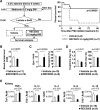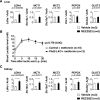Targeting Oxygen-Sensing Prolyl Hydroxylase for Metformin-Associated Lactic Acidosis Treatment
- PMID: 28606929
- PMCID: PMC5533879
- DOI: 10.1128/MCB.00248-17
Targeting Oxygen-Sensing Prolyl Hydroxylase for Metformin-Associated Lactic Acidosis Treatment
Abstract
Metformin is one of the most widely used therapeutics for type 2 diabetes mellitus and also has anticancer and antiaging properties. However, it is known to induce metformin-associated lactic acidosis (MALA), a severe medical condition with poor prognosis, especially in individuals with renal dysfunction. Inhibition of prolyl hydroxylase (PHD) is known to activate the transcription factor hypoxia-inducible factor (HIF) that increases lactate efflux as a result of enhanced glycolysis, but it also enhances gluconeogenesis from lactate in the liver that contributes to reducing circulating lactate levels. Here, we investigated the outcome of pharmaceutical inhibition of PHD in mice with MALA induced through the administration of metformin per os and an intraperitoneal injection of lactic acid. We found that the PHD inhibitors significantly increased the expression levels of genes involved in gluconeogenesis in the liver and the kidney and significantly improved the survival of mice with MALA. Furthermore, the PHD inhibitor also improved the rate of survival of MALA induced in mice with chronic kidney disease (CKD). Thus, PHD represents a new therapeutic target for MALA, which is a critical complication of metformin therapy.
Keywords: CKD; Cori cycle; HIF; MALA; PHD; gluconeogenesis; hypoxia; lactic acidosis; metformin; prolyl hydroxylase.
Copyright © 2017 American Society for Microbiology.
Figures






Similar articles
-
Inhibition of the oxygen sensor PHD2 in the liver improves survival in lactic acidosis by activating the Cori cycle.Proc Natl Acad Sci U S A. 2015 Sep 15;112(37):11642-7. doi: 10.1073/pnas.1515872112. Epub 2015 Aug 31. Proc Natl Acad Sci U S A. 2015. PMID: 26324945 Free PMC article.
-
Metformin associated lactic acidosis (MALA): clinical profiling and management.J Nephrol. 2016 Dec;29(6):783-789. doi: 10.1007/s40620-016-0267-8. Epub 2016 Jan 22. J Nephrol. 2016. PMID: 26800971 Review.
-
Metformin-related lactic acidosis: is it a myth or an underestimated reality?Ren Fail. 2016 Oct;38(9):1560-1565. doi: 10.1080/0886022X.2016.1216723. Epub 2016 Aug 10. Ren Fail. 2016. PMID: 27686366 Review.
-
GC-MS analysis of 4-hydroxyproline: elevated proline hydroxylation in metformin-associated lactic acidosis and metformin-treated Becker muscular dystrophy patients.Amino Acids. 2024 Mar 10;56(1):21. doi: 10.1007/s00726-024-03383-9. Amino Acids. 2024. PMID: 38461423 Free PMC article.
-
Metformin-associated lactic acidosis: Current perspectives on causes and risk.Metabolism. 2016 Feb;65(2):20-9. doi: 10.1016/j.metabol.2015.10.014. Epub 2015 Oct 9. Metabolism. 2016. PMID: 26773926 Review.
Cited by
-
The evidence of metabolic-improving effect of metformin in Ay/a mice with genetically-induced melanocortin obesity and the contribution of hypothalamic mechanisms to this effect.PLoS One. 2019 Mar 14;14(3):e0213779. doi: 10.1371/journal.pone.0213779. eCollection 2019. PLoS One. 2019. PMID: 30870482 Free PMC article.
-
Objective and Quantitative Evaluation of Spontaneous Pain-Like Behaviors Using Dynamic Weight-Bearing System in Mouse Models of Postsurgical Pain.J Pain Res. 2022 Jun 2;15:1601-1612. doi: 10.2147/JPR.S359220. eCollection 2022. J Pain Res. 2022. PMID: 35685298 Free PMC article.
-
Daurisoline inhibits glycolysis of lung cancer by targeting the AKT-HK2 axis.Cancer Biol Ther. 2025 Dec;26(1):2442556. doi: 10.1080/15384047.2024.2442556. Epub 2024 Dec 19. Cancer Biol Ther. 2025. PMID: 39699276 Free PMC article.
-
Adjuvant therapies for management of hemorrhagic shock: a narrative review.Crit Care. 2025 Mar 29;29(1):138. doi: 10.1186/s13054-025-05368-w. Crit Care. 2025. PMID: 40158128 Free PMC article.
-
Metformin-Induced Lactic Acidosis: A Case Study.Cureus. 2018 Feb 4;10(2):e2152. doi: 10.7759/cureus.2152. Cureus. 2018. PMID: 29637033 Free PMC article.
References
-
- Suhara T, Hishiki T, Kasahara M, Hayakawa N, Oyaizu T, Nakanishi T, Kubo A, Morisaki H, Kaelin WG Jr, Suematsu M, Minamishima YA. 2015. Inhibition of the oxygen sensor PHD2 in the liver improves survival in lactic acidosis by activating the Cori cycle. Proc Natl Acad Sci U S A 112:11642–11647. doi:10.1073/pnas.1515872112. - DOI - PMC - PubMed
MeSH terms
Substances
LinkOut - more resources
Full Text Sources
Other Literature Sources
